Analysis of Influences on Health and Social Care Organisations
VerifiedAdded on 2020/01/07
|11
|1538
|150
Report
AI Summary
This report examines the various influences on health and social care organizations, focusing on the National Health Service (NHS). It explores the importance of organizational structure (horizontal vs. vertical) and how the vertical structure is often more appropriate for healthcare. The report also analyzes organizational culture, emphasizing shared values and their impact on employee behavior, financial performance, and patient satisfaction. Furthermore, it delves into individual and group behavior theories, such as the Big Five Personality model and the MARS model, highlighting how these theories influence employee actions within healthcare settings. The report also discusses leadership styles, including autocratic, democratic, and transformational leadership, and their effects on employee motivation and the overall effectiveness of health and social care entities. The conclusion summarizes the key findings, emphasizing the significance of structure, culture, and leadership in fostering a positive and efficient healthcare environment.
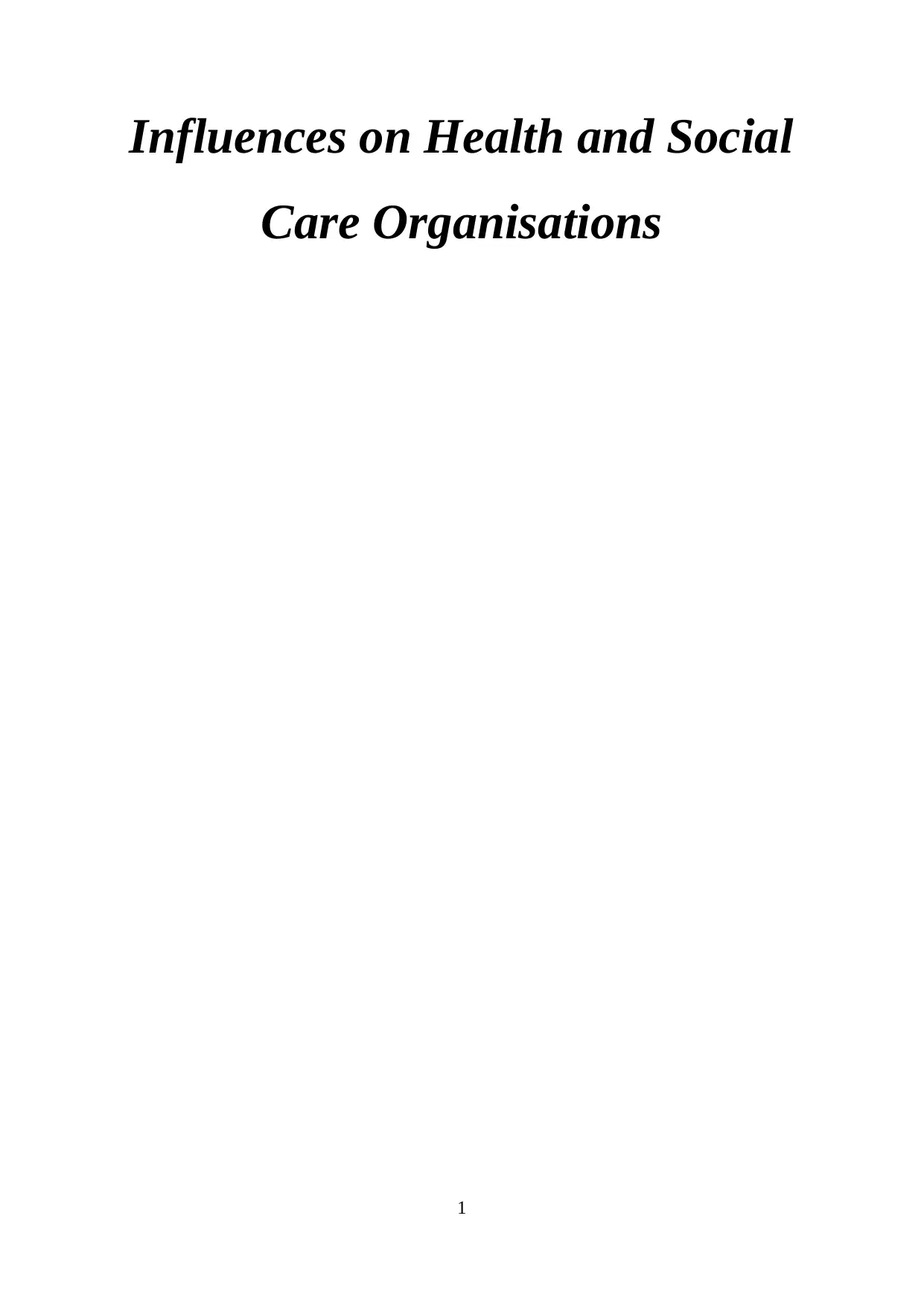
Influences on Health and Social
Care Organisations
1
Care Organisations
1
Paraphrase This Document
Need a fresh take? Get an instant paraphrase of this document with our AI Paraphraser
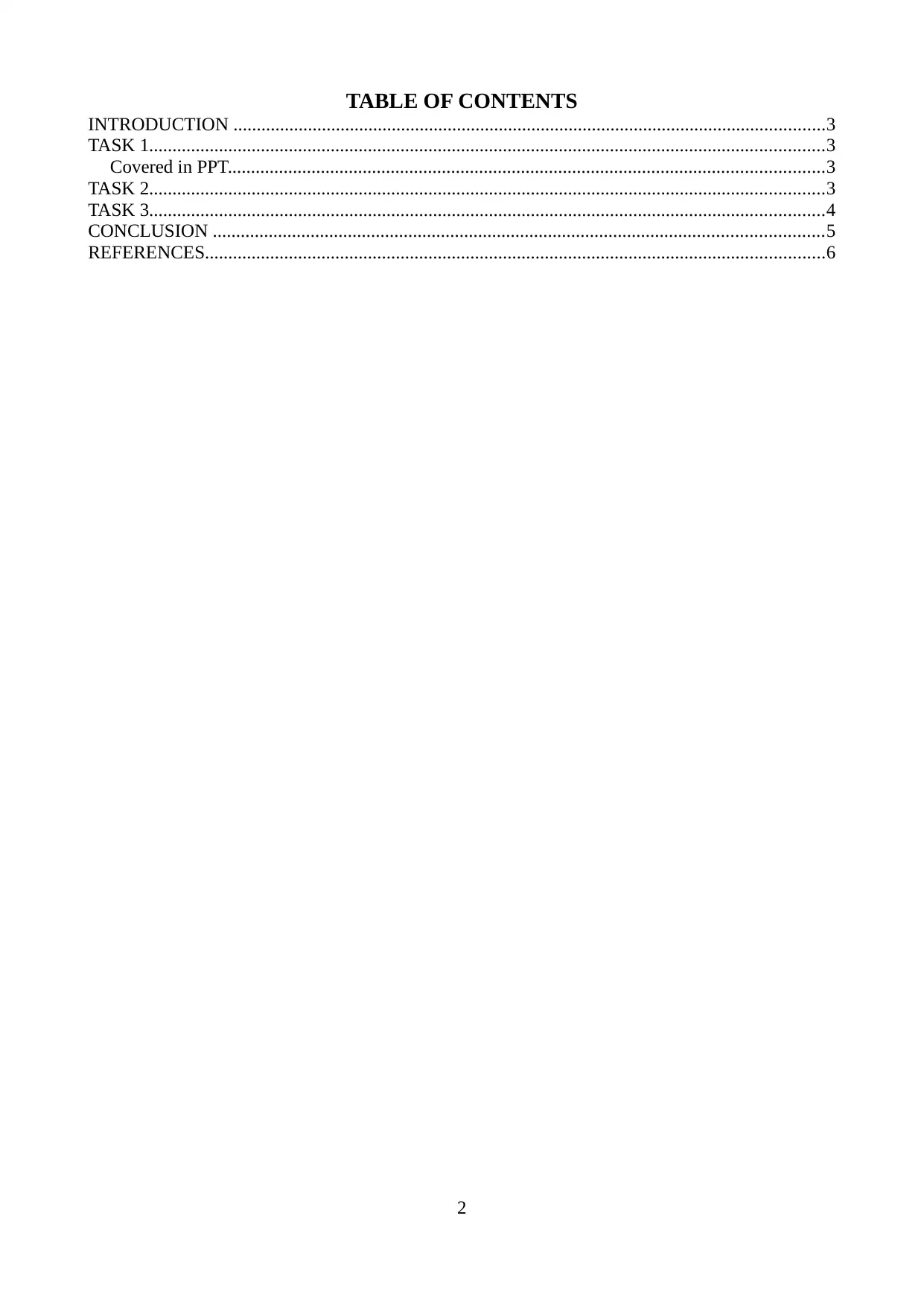
TABLE OF CONTENTS
INTRODUCTION ...............................................................................................................................3
TASK 1.................................................................................................................................................3
Covered in PPT................................................................................................................................3
TASK 2.................................................................................................................................................3
TASK 3.................................................................................................................................................4
CONCLUSION ...................................................................................................................................5
REFERENCES.....................................................................................................................................6
2
INTRODUCTION ...............................................................................................................................3
TASK 1.................................................................................................................................................3
Covered in PPT................................................................................................................................3
TASK 2.................................................................................................................................................3
TASK 3.................................................................................................................................................4
CONCLUSION ...................................................................................................................................5
REFERENCES.....................................................................................................................................6
2
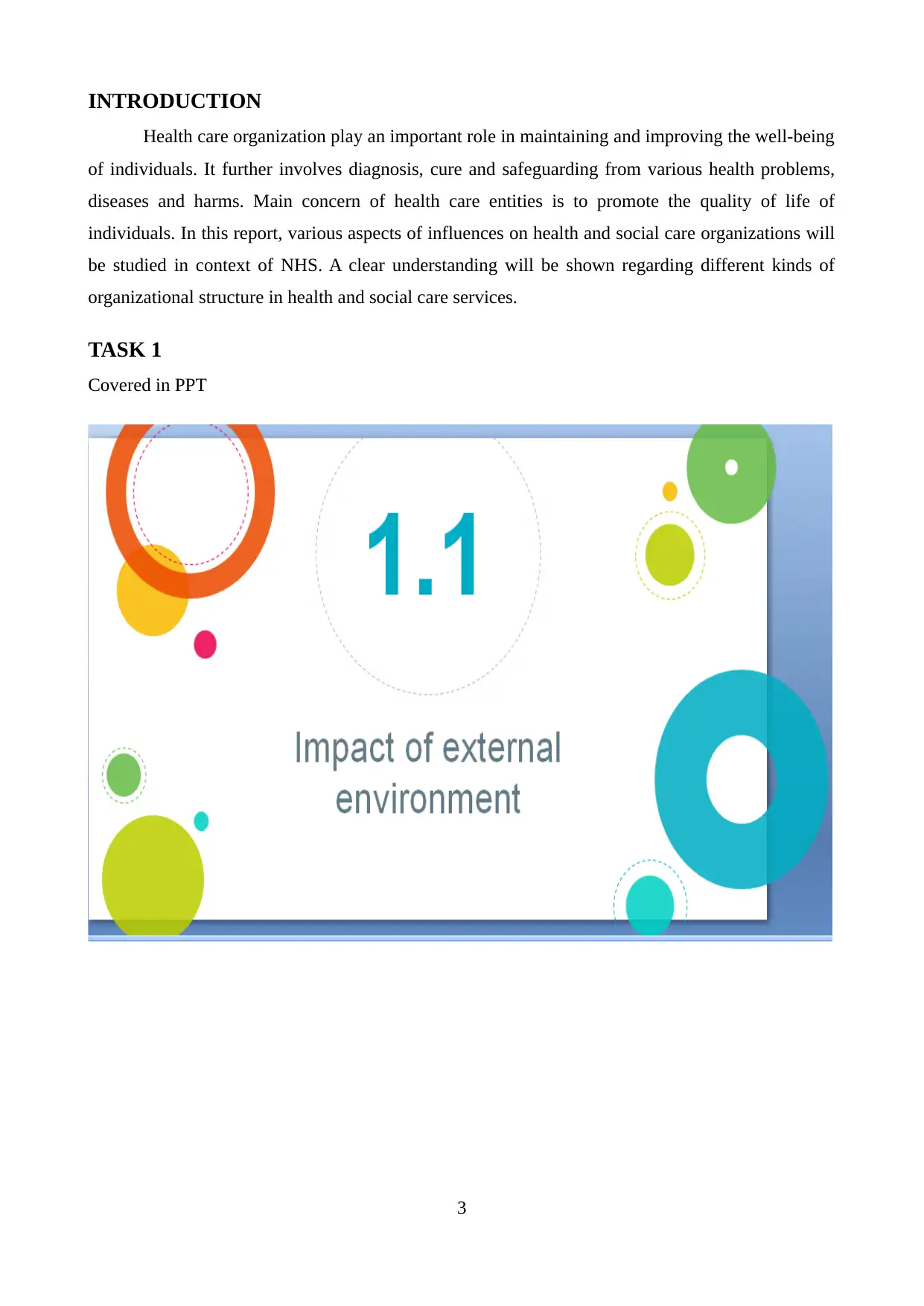
INTRODUCTION
Health care organization play an important role in maintaining and improving the well-being
of individuals. It further involves diagnosis, cure and safeguarding from various health problems,
diseases and harms. Main concern of health care entities is to promote the quality of life of
individuals. In this report, various aspects of influences on health and social care organizations will
be studied in context of NHS. A clear understanding will be shown regarding different kinds of
organizational structure in health and social care services.
TASK 1
Covered in PPT
3
Health care organization play an important role in maintaining and improving the well-being
of individuals. It further involves diagnosis, cure and safeguarding from various health problems,
diseases and harms. Main concern of health care entities is to promote the quality of life of
individuals. In this report, various aspects of influences on health and social care organizations will
be studied in context of NHS. A clear understanding will be shown regarding different kinds of
organizational structure in health and social care services.
TASK 1
Covered in PPT
3
⊘ This is a preview!⊘
Do you want full access?
Subscribe today to unlock all pages.

Trusted by 1+ million students worldwide
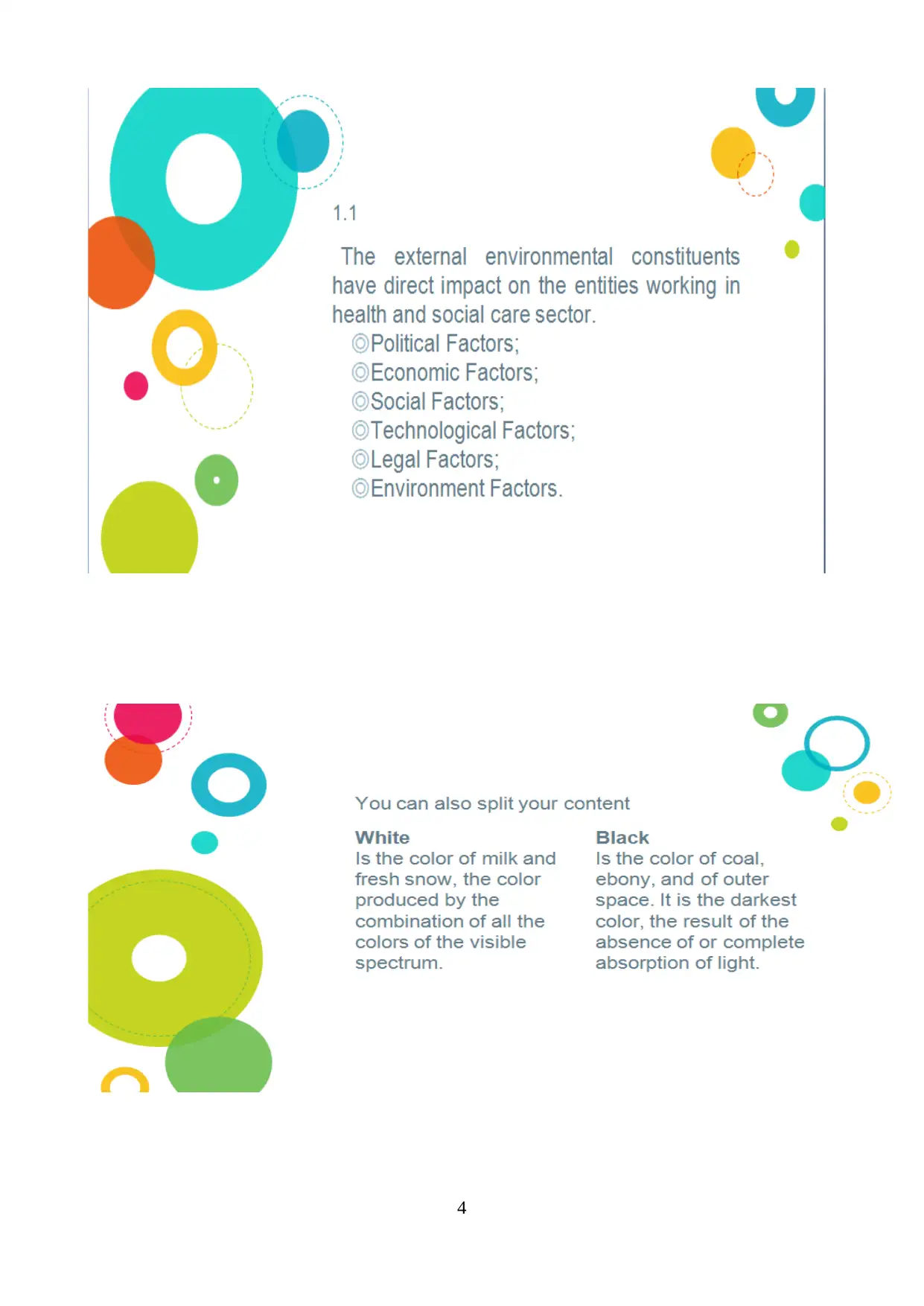
4
Paraphrase This Document
Need a fresh take? Get an instant paraphrase of this document with our AI Paraphraser
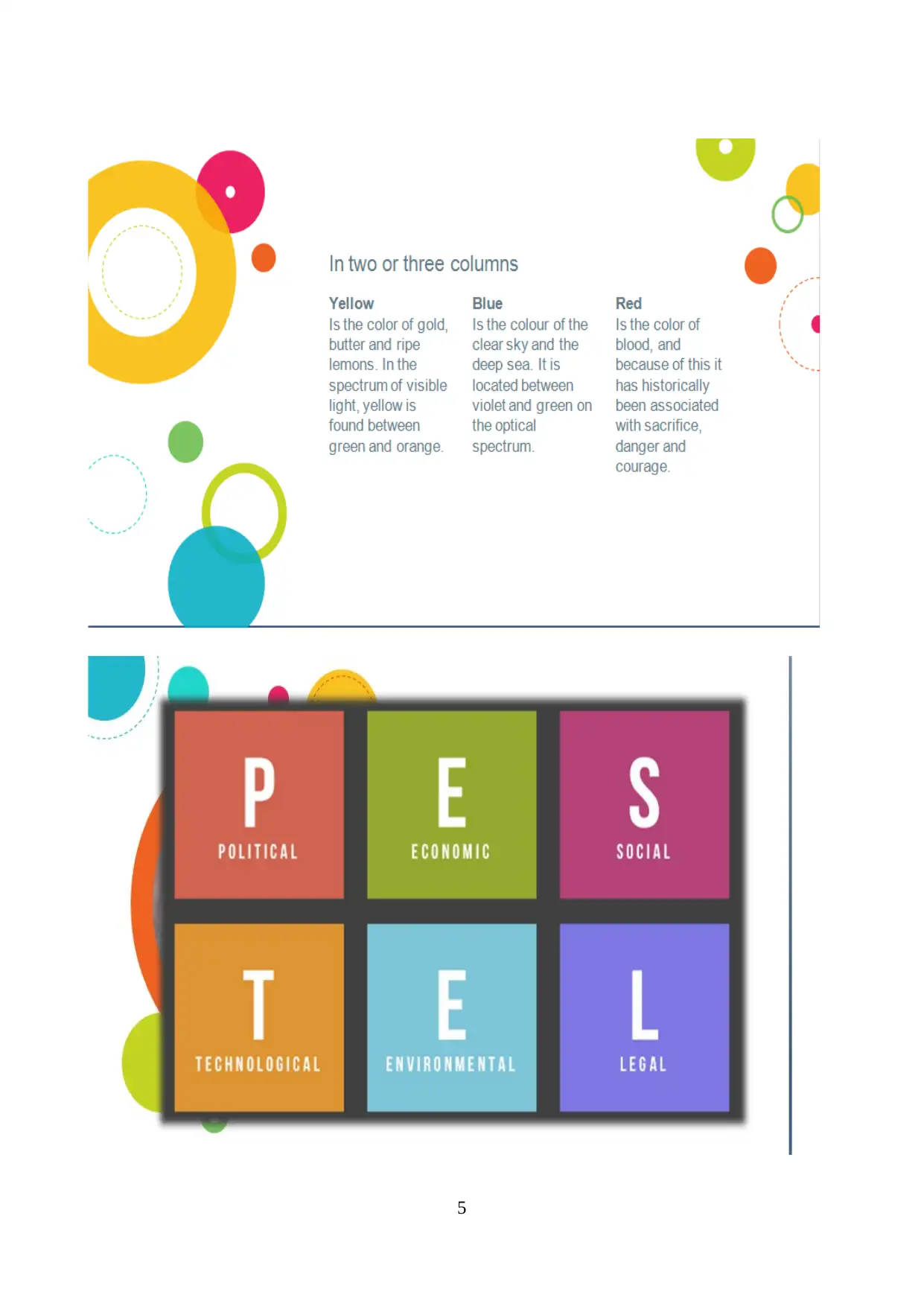
5
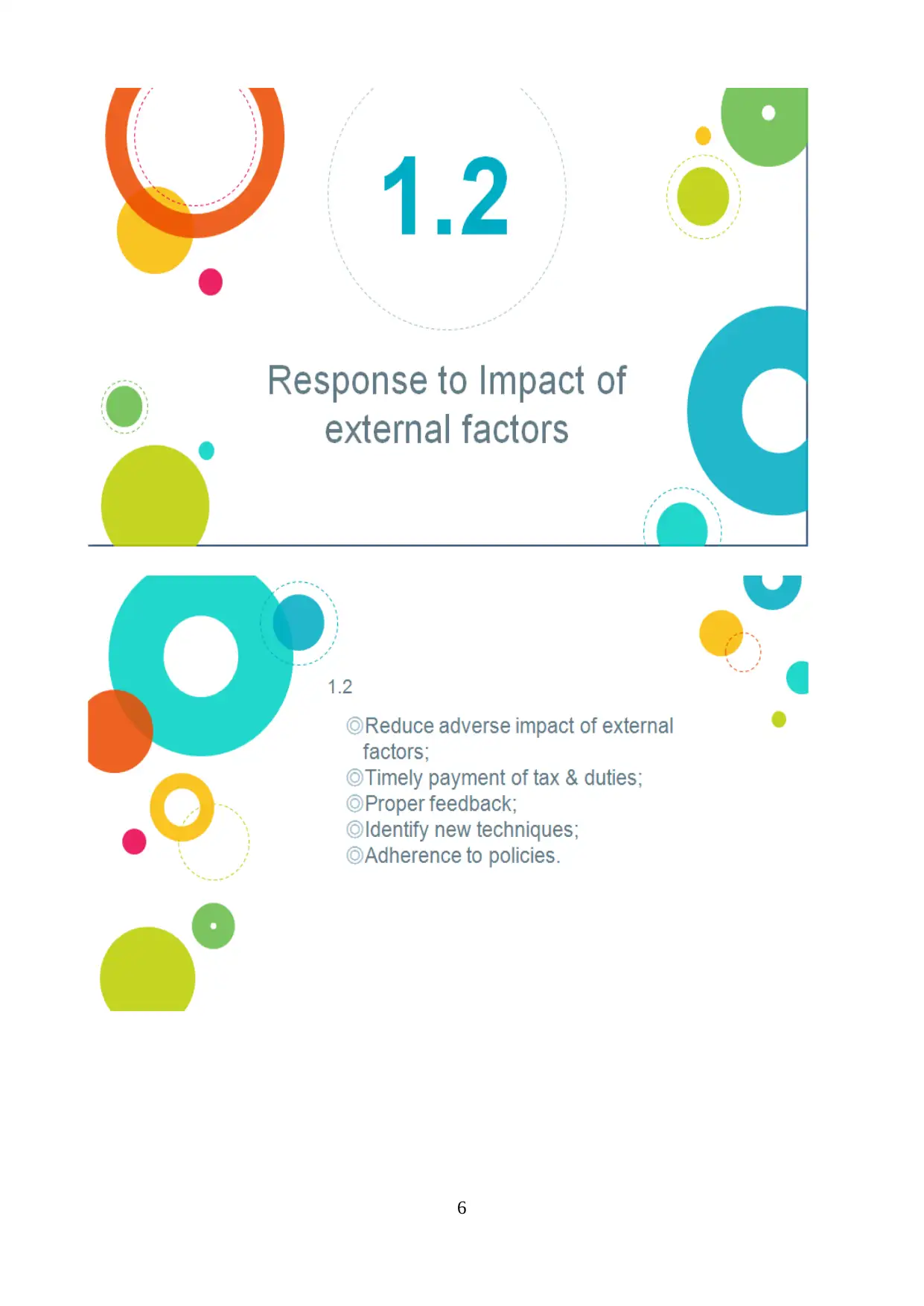
6
⊘ This is a preview!⊘
Do you want full access?
Subscribe today to unlock all pages.

Trusted by 1+ million students worldwide
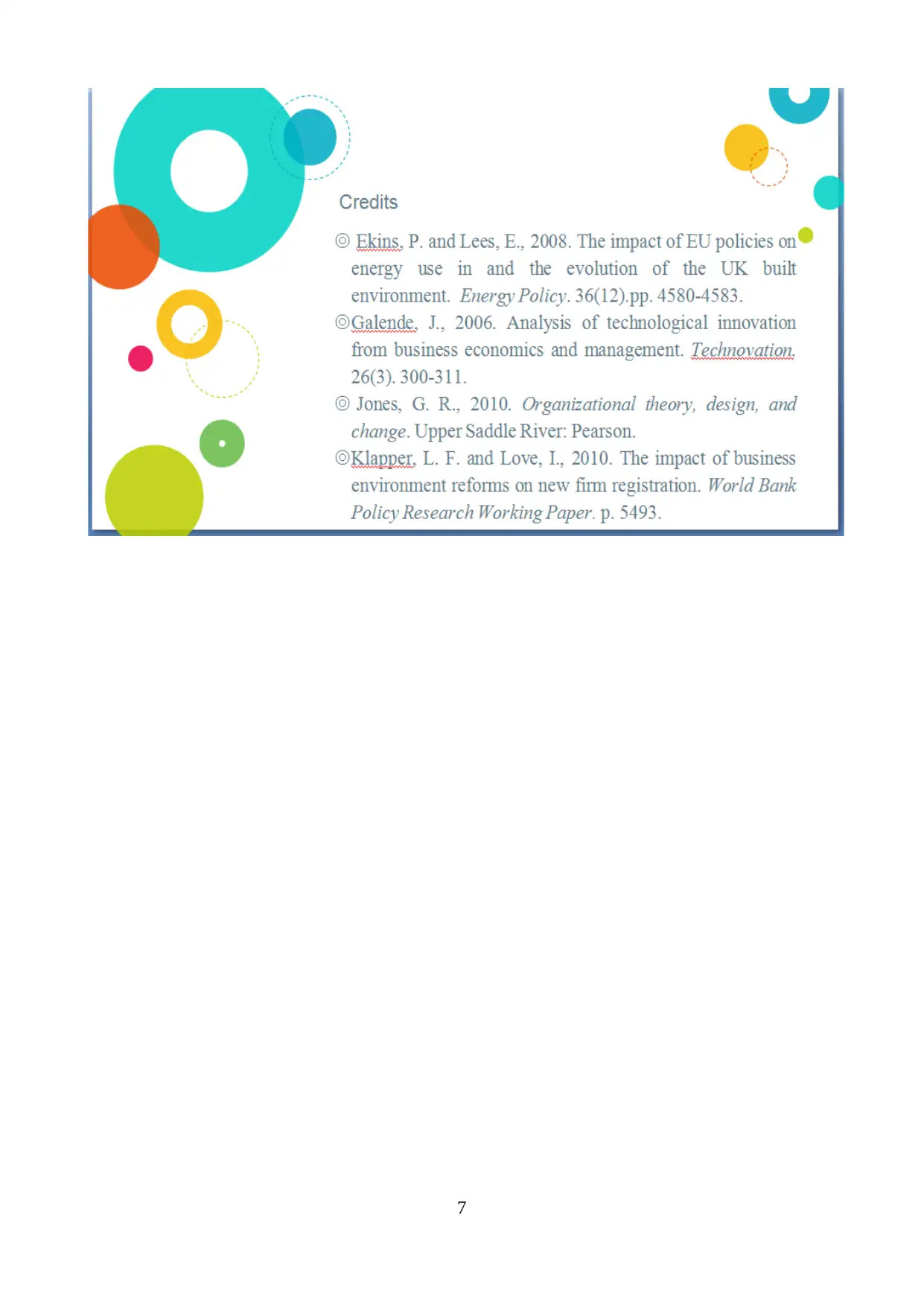
7
Paraphrase This Document
Need a fresh take? Get an instant paraphrase of this document with our AI Paraphraser
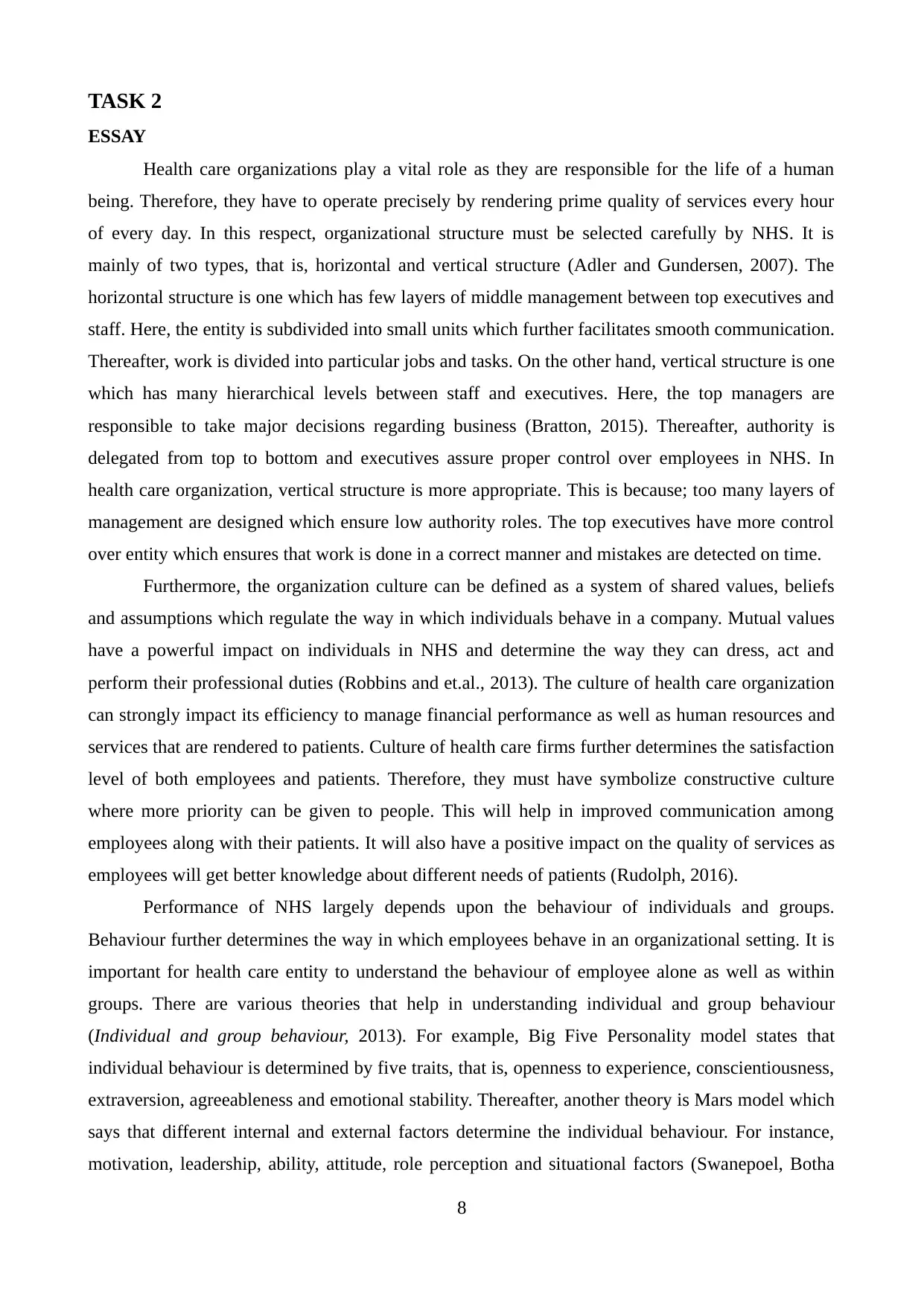
TASK 2
ESSAY
Health care organizations play a vital role as they are responsible for the life of a human
being. Therefore, they have to operate precisely by rendering prime quality of services every hour
of every day. In this respect, organizational structure must be selected carefully by NHS. It is
mainly of two types, that is, horizontal and vertical structure (Adler and Gundersen, 2007). The
horizontal structure is one which has few layers of middle management between top executives and
staff. Here, the entity is subdivided into small units which further facilitates smooth communication.
Thereafter, work is divided into particular jobs and tasks. On the other hand, vertical structure is one
which has many hierarchical levels between staff and executives. Here, the top managers are
responsible to take major decisions regarding business (Bratton, 2015). Thereafter, authority is
delegated from top to bottom and executives assure proper control over employees in NHS. In
health care organization, vertical structure is more appropriate. This is because; too many layers of
management are designed which ensure low authority roles. The top executives have more control
over entity which ensures that work is done in a correct manner and mistakes are detected on time.
Furthermore, the organization culture can be defined as a system of shared values, beliefs
and assumptions which regulate the way in which individuals behave in a company. Mutual values
have a powerful impact on individuals in NHS and determine the way they can dress, act and
perform their professional duties (Robbins and et.al., 2013). The culture of health care organization
can strongly impact its efficiency to manage financial performance as well as human resources and
services that are rendered to patients. Culture of health care firms further determines the satisfaction
level of both employees and patients. Therefore, they must have symbolize constructive culture
where more priority can be given to people. This will help in improved communication among
employees along with their patients. It will also have a positive impact on the quality of services as
employees will get better knowledge about different needs of patients (Rudolph, 2016).
Performance of NHS largely depends upon the behaviour of individuals and groups.
Behaviour further determines the way in which employees behave in an organizational setting. It is
important for health care entity to understand the behaviour of employee alone as well as within
groups. There are various theories that help in understanding individual and group behaviour
(Individual and group behaviour, 2013). For example, Big Five Personality model states that
individual behaviour is determined by five traits, that is, openness to experience, conscientiousness,
extraversion, agreeableness and emotional stability. Thereafter, another theory is Mars model which
says that different internal and external factors determine the individual behaviour. For instance,
motivation, leadership, ability, attitude, role perception and situational factors (Swanepoel, Botha
8
ESSAY
Health care organizations play a vital role as they are responsible for the life of a human
being. Therefore, they have to operate precisely by rendering prime quality of services every hour
of every day. In this respect, organizational structure must be selected carefully by NHS. It is
mainly of two types, that is, horizontal and vertical structure (Adler and Gundersen, 2007). The
horizontal structure is one which has few layers of middle management between top executives and
staff. Here, the entity is subdivided into small units which further facilitates smooth communication.
Thereafter, work is divided into particular jobs and tasks. On the other hand, vertical structure is one
which has many hierarchical levels between staff and executives. Here, the top managers are
responsible to take major decisions regarding business (Bratton, 2015). Thereafter, authority is
delegated from top to bottom and executives assure proper control over employees in NHS. In
health care organization, vertical structure is more appropriate. This is because; too many layers of
management are designed which ensure low authority roles. The top executives have more control
over entity which ensures that work is done in a correct manner and mistakes are detected on time.
Furthermore, the organization culture can be defined as a system of shared values, beliefs
and assumptions which regulate the way in which individuals behave in a company. Mutual values
have a powerful impact on individuals in NHS and determine the way they can dress, act and
perform their professional duties (Robbins and et.al., 2013). The culture of health care organization
can strongly impact its efficiency to manage financial performance as well as human resources and
services that are rendered to patients. Culture of health care firms further determines the satisfaction
level of both employees and patients. Therefore, they must have symbolize constructive culture
where more priority can be given to people. This will help in improved communication among
employees along with their patients. It will also have a positive impact on the quality of services as
employees will get better knowledge about different needs of patients (Rudolph, 2016).
Performance of NHS largely depends upon the behaviour of individuals and groups.
Behaviour further determines the way in which employees behave in an organizational setting. It is
important for health care entity to understand the behaviour of employee alone as well as within
groups. There are various theories that help in understanding individual and group behaviour
(Individual and group behaviour, 2013). For example, Big Five Personality model states that
individual behaviour is determined by five traits, that is, openness to experience, conscientiousness,
extraversion, agreeableness and emotional stability. Thereafter, another theory is Mars model which
says that different internal and external factors determine the individual behaviour. For instance,
motivation, leadership, ability, attitude, role perception and situational factors (Swanepoel, Botha
8
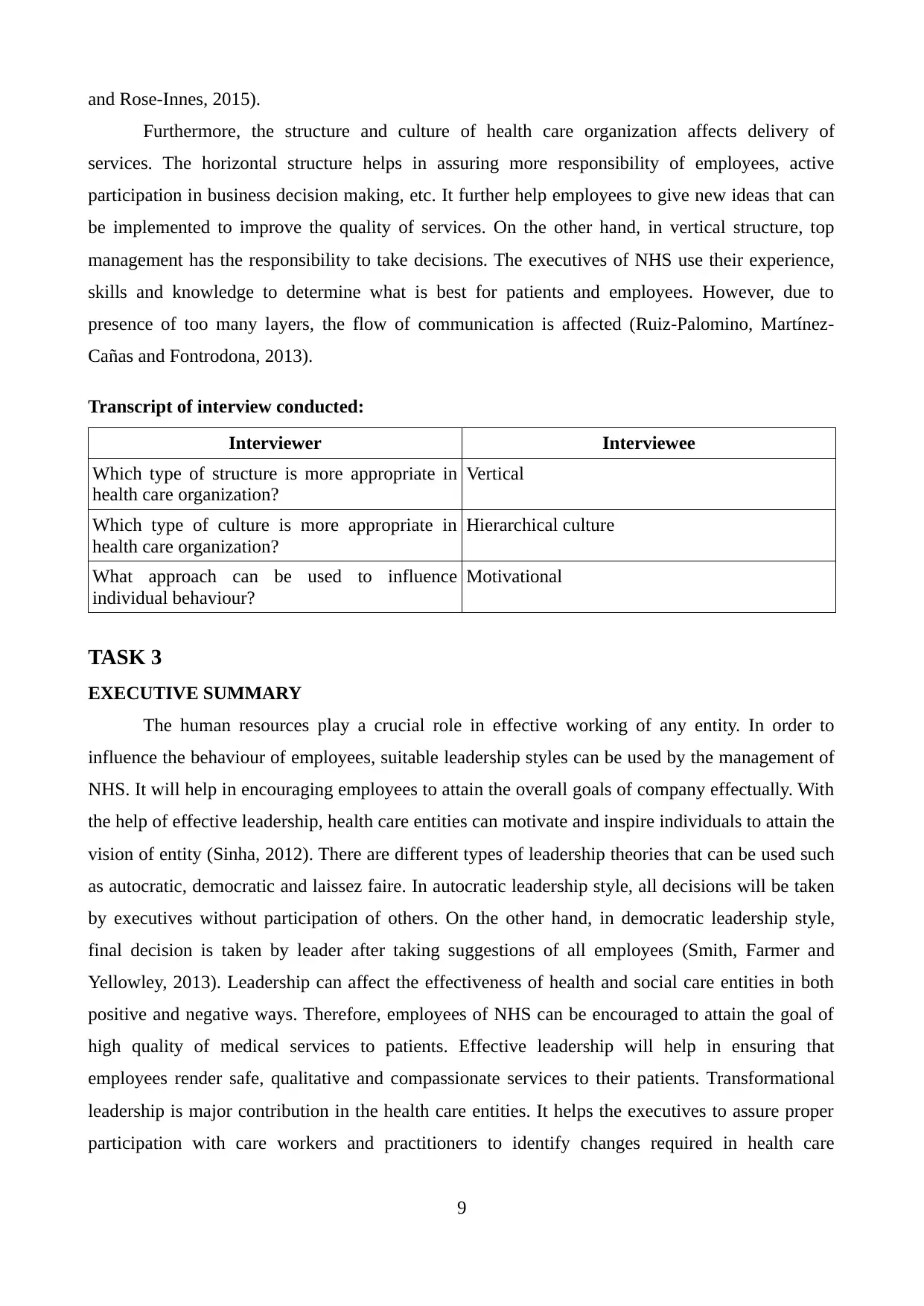
and Rose-Innes, 2015).
Furthermore, the structure and culture of health care organization affects delivery of
services. The horizontal structure helps in assuring more responsibility of employees, active
participation in business decision making, etc. It further help employees to give new ideas that can
be implemented to improve the quality of services. On the other hand, in vertical structure, top
management has the responsibility to take decisions. The executives of NHS use their experience,
skills and knowledge to determine what is best for patients and employees. However, due to
presence of too many layers, the flow of communication is affected (Ruiz-Palomino, Martínez-
Cañas and Fontrodona, 2013).
Transcript of interview conducted:
Interviewer Interviewee
Which type of structure is more appropriate in
health care organization?
Vertical
Which type of culture is more appropriate in
health care organization?
Hierarchical culture
What approach can be used to influence
individual behaviour?
Motivational
TASK 3
EXECUTIVE SUMMARY
The human resources play a crucial role in effective working of any entity. In order to
influence the behaviour of employees, suitable leadership styles can be used by the management of
NHS. It will help in encouraging employees to attain the overall goals of company effectually. With
the help of effective leadership, health care entities can motivate and inspire individuals to attain the
vision of entity (Sinha, 2012). There are different types of leadership theories that can be used such
as autocratic, democratic and laissez faire. In autocratic leadership style, all decisions will be taken
by executives without participation of others. On the other hand, in democratic leadership style,
final decision is taken by leader after taking suggestions of all employees (Smith, Farmer and
Yellowley, 2013). Leadership can affect the effectiveness of health and social care entities in both
positive and negative ways. Therefore, employees of NHS can be encouraged to attain the goal of
high quality of medical services to patients. Effective leadership will help in ensuring that
employees render safe, qualitative and compassionate services to their patients. Transformational
leadership is major contribution in the health care entities. It helps the executives to assure proper
participation with care workers and practitioners to identify changes required in health care
9
Furthermore, the structure and culture of health care organization affects delivery of
services. The horizontal structure helps in assuring more responsibility of employees, active
participation in business decision making, etc. It further help employees to give new ideas that can
be implemented to improve the quality of services. On the other hand, in vertical structure, top
management has the responsibility to take decisions. The executives of NHS use their experience,
skills and knowledge to determine what is best for patients and employees. However, due to
presence of too many layers, the flow of communication is affected (Ruiz-Palomino, Martínez-
Cañas and Fontrodona, 2013).
Transcript of interview conducted:
Interviewer Interviewee
Which type of structure is more appropriate in
health care organization?
Vertical
Which type of culture is more appropriate in
health care organization?
Hierarchical culture
What approach can be used to influence
individual behaviour?
Motivational
TASK 3
EXECUTIVE SUMMARY
The human resources play a crucial role in effective working of any entity. In order to
influence the behaviour of employees, suitable leadership styles can be used by the management of
NHS. It will help in encouraging employees to attain the overall goals of company effectually. With
the help of effective leadership, health care entities can motivate and inspire individuals to attain the
vision of entity (Sinha, 2012). There are different types of leadership theories that can be used such
as autocratic, democratic and laissez faire. In autocratic leadership style, all decisions will be taken
by executives without participation of others. On the other hand, in democratic leadership style,
final decision is taken by leader after taking suggestions of all employees (Smith, Farmer and
Yellowley, 2013). Leadership can affect the effectiveness of health and social care entities in both
positive and negative ways. Therefore, employees of NHS can be encouraged to attain the goal of
high quality of medical services to patients. Effective leadership will help in ensuring that
employees render safe, qualitative and compassionate services to their patients. Transformational
leadership is major contribution in the health care entities. It helps the executives to assure proper
participation with care workers and practitioners to identify changes required in health care
9
⊘ This is a preview!⊘
Do you want full access?
Subscribe today to unlock all pages.

Trusted by 1+ million students worldwide
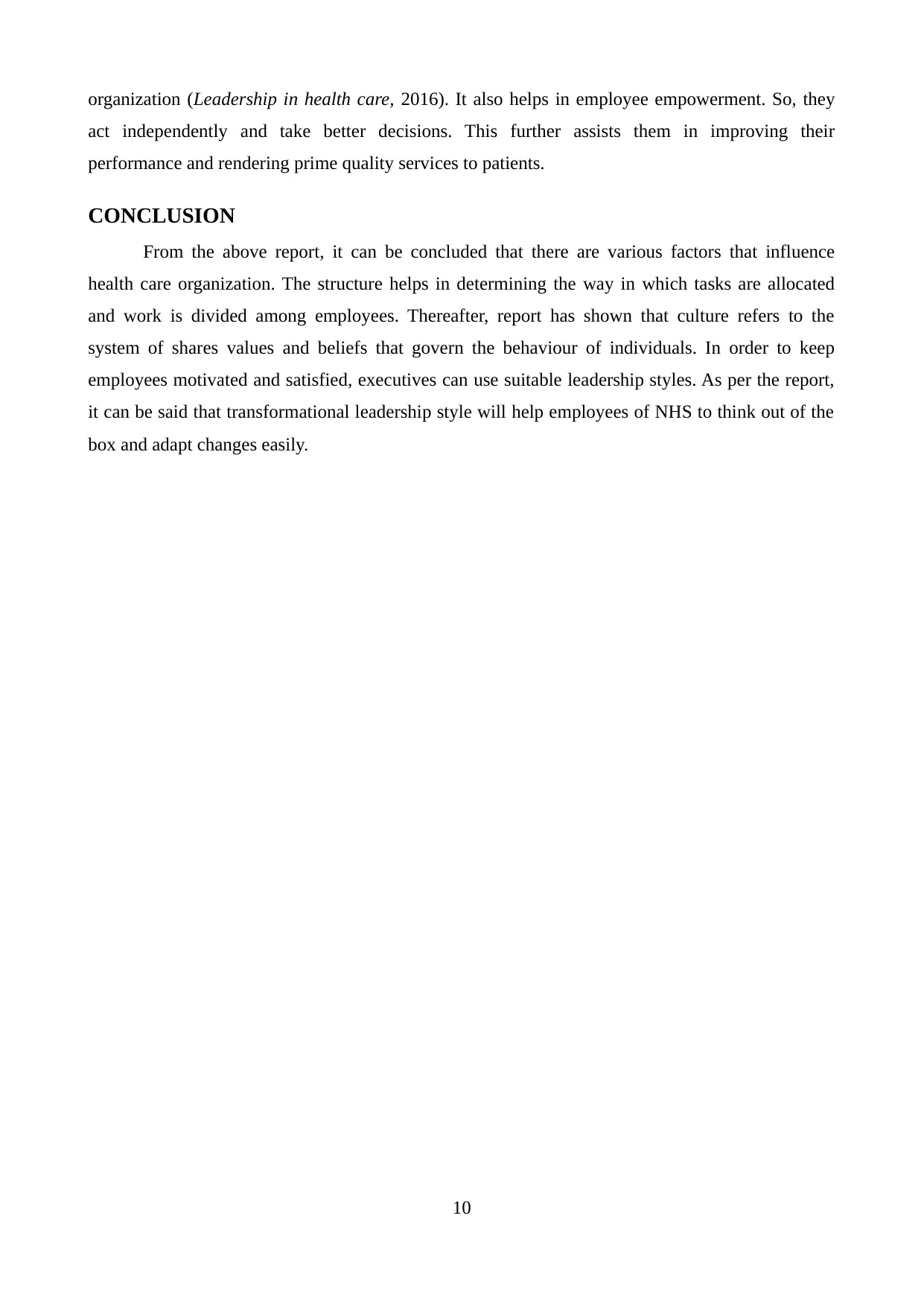
organization (Leadership in health care, 2016). It also helps in employee empowerment. So, they
act independently and take better decisions. This further assists them in improving their
performance and rendering prime quality services to patients.
CONCLUSION
From the above report, it can be concluded that there are various factors that influence
health care organization. The structure helps in determining the way in which tasks are allocated
and work is divided among employees. Thereafter, report has shown that culture refers to the
system of shares values and beliefs that govern the behaviour of individuals. In order to keep
employees motivated and satisfied, executives can use suitable leadership styles. As per the report,
it can be said that transformational leadership style will help employees of NHS to think out of the
box and adapt changes easily.
10
act independently and take better decisions. This further assists them in improving their
performance and rendering prime quality services to patients.
CONCLUSION
From the above report, it can be concluded that there are various factors that influence
health care organization. The structure helps in determining the way in which tasks are allocated
and work is divided among employees. Thereafter, report has shown that culture refers to the
system of shares values and beliefs that govern the behaviour of individuals. In order to keep
employees motivated and satisfied, executives can use suitable leadership styles. As per the report,
it can be said that transformational leadership style will help employees of NHS to think out of the
box and adapt changes easily.
10
Paraphrase This Document
Need a fresh take? Get an instant paraphrase of this document with our AI Paraphraser
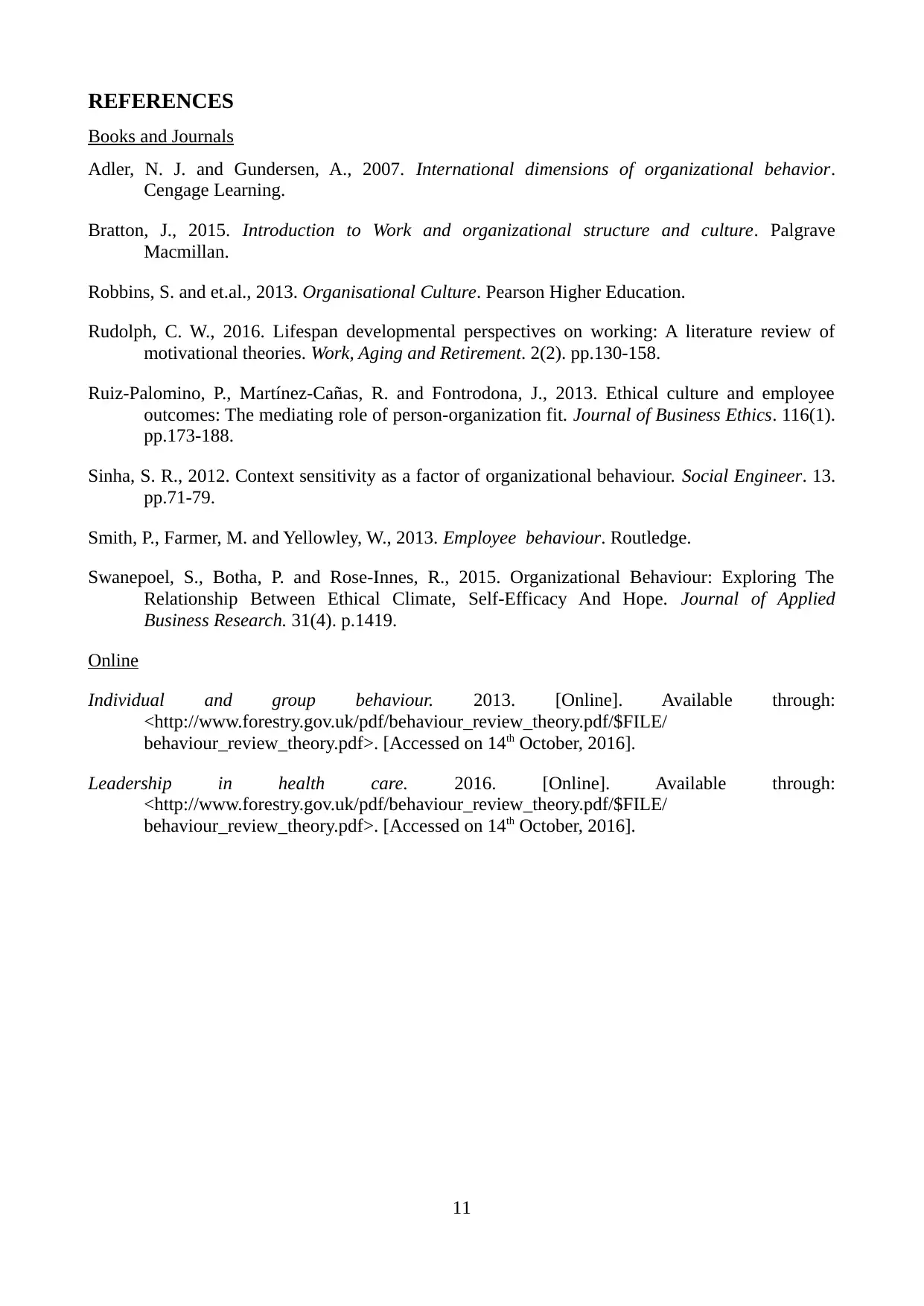
REFERENCES
Books and Journals
Adler, N. J. and Gundersen, A., 2007. International dimensions of organizational behavior.
Cengage Learning.
Bratton, J., 2015. Introduction to Work and organizational structure and culture. Palgrave
Macmillan.
Robbins, S. and et.al., 2013. Organisational Culture. Pearson Higher Education.
Rudolph, C. W., 2016. Lifespan developmental perspectives on working: A literature review of
motivational theories. Work, Aging and Retirement. 2(2). pp.130-158.
Ruiz-Palomino, P., Martínez-Cañas, R. and Fontrodona, J., 2013. Ethical culture and employee
outcomes: The mediating role of person-organization fit. Journal of Business Ethics. 116(1).
pp.173-188.
Sinha, S. R., 2012. Context sensitivity as a factor of organizational behaviour. Social Engineer. 13.
pp.71-79.
Smith, P., Farmer, M. and Yellowley, W., 2013. Employee behaviour. Routledge.
Swanepoel, S., Botha, P. and Rose-Innes, R., 2015. Organizational Behaviour: Exploring The
Relationship Between Ethical Climate, Self-Efficacy And Hope. Journal of Applied
Business Research. 31(4). p.1419.
Online
Individual and group behaviour. 2013. [Online]. Available through:
<http://www.forestry.gov.uk/pdf/behaviour_review_theory.pdf/$FILE/
behaviour_review_theory.pdf>. [Accessed on 14th October, 2016].
Leadership in health care. 2016. [Online]. Available through:
<http://www.forestry.gov.uk/pdf/behaviour_review_theory.pdf/$FILE/
behaviour_review_theory.pdf>. [Accessed on 14th October, 2016].
11
Books and Journals
Adler, N. J. and Gundersen, A., 2007. International dimensions of organizational behavior.
Cengage Learning.
Bratton, J., 2015. Introduction to Work and organizational structure and culture. Palgrave
Macmillan.
Robbins, S. and et.al., 2013. Organisational Culture. Pearson Higher Education.
Rudolph, C. W., 2016. Lifespan developmental perspectives on working: A literature review of
motivational theories. Work, Aging and Retirement. 2(2). pp.130-158.
Ruiz-Palomino, P., Martínez-Cañas, R. and Fontrodona, J., 2013. Ethical culture and employee
outcomes: The mediating role of person-organization fit. Journal of Business Ethics. 116(1).
pp.173-188.
Sinha, S. R., 2012. Context sensitivity as a factor of organizational behaviour. Social Engineer. 13.
pp.71-79.
Smith, P., Farmer, M. and Yellowley, W., 2013. Employee behaviour. Routledge.
Swanepoel, S., Botha, P. and Rose-Innes, R., 2015. Organizational Behaviour: Exploring The
Relationship Between Ethical Climate, Self-Efficacy And Hope. Journal of Applied
Business Research. 31(4). p.1419.
Online
Individual and group behaviour. 2013. [Online]. Available through:
<http://www.forestry.gov.uk/pdf/behaviour_review_theory.pdf/$FILE/
behaviour_review_theory.pdf>. [Accessed on 14th October, 2016].
Leadership in health care. 2016. [Online]. Available through:
<http://www.forestry.gov.uk/pdf/behaviour_review_theory.pdf/$FILE/
behaviour_review_theory.pdf>. [Accessed on 14th October, 2016].
11
1 out of 11
Related Documents
Your All-in-One AI-Powered Toolkit for Academic Success.
+13062052269
info@desklib.com
Available 24*7 on WhatsApp / Email
![[object Object]](/_next/static/media/star-bottom.7253800d.svg)
Unlock your academic potential
Copyright © 2020–2025 A2Z Services. All Rights Reserved. Developed and managed by ZUCOL.





